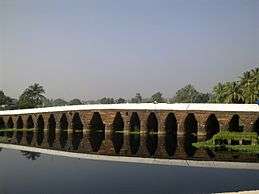Atharanala
| Atharanala ଅଠରନଳା | |
|---|---|
 Atharanala bridge viewed from NH-316 | |
| Coordinates | 19°49′11″N 85°49′54″E / 19.819810°N 85.831710°ECoordinates: 19°49′11″N 85°49′54″E / 19.819810°N 85.831710°E |
| Carries | light vehicles, pedestrians |
| Crosses | Madhupur[1] or Musa[2] stream |
| Locale | Puri town, Odisha, India |
| Other name(s) | Hulhuliya bridge[2] |
| Named for | 18-passages |
| Heritage status | Monument of National Importance N-OR-64[1] |
| Characteristics | |
| Design | medieval architectural scheme of pillars and arches; ashlar masonry |
| Material | laterite stone |
| Trough construction | lime mortar |
| Total length | 85,5 m |
| Width | 12 m |
| Height | 6,3 m |
| Traversable? | no |
| Number of spans | 18 |
| Piers in water | 19 |
| History | |
| Construction begin | second half of the 18th century AD |
Atharanala (Odia: ଅଠରନଳା) - a historic laterite stone bridge over the Madhupur[1] or Musa[2] stream at the entrance of Puri town, Odisha (India) on Puri - Bhubaneswar road, locally known as Hulhuliya bridge; a Monument of National Importance N-OR-64[1] officially recognized by Archaeological Survey of India. Due to safety reasons the bridge is excluded from heavy vehicle traffic. The bridge spreads over a length of 85 meter (280 feet) and breadth of 11 meter (36 feet) and encompasses eighteen arches (“athara” means eighteen, “nala” canals or passages) ranging from seven to sixteen feet across. The bridge offers a spectacular long distance view of the Jagannath Temple.[3] The bridge is made of laterite in medieval architectural scheme of pillars and arches. According to the report of the Indira Gandhi National Centre for the Arts the structure was assigned to the second half of the 18th century AD based on architectural ground and building materials.[2]
The present bridge has been placed directly on top of the structure[4] which had been started as early as 13th century AD[5] by Bhanu Deva I (1266–1278) of the Eastern Ganga Dynasty and continued by Narasimha Deva II (1279–1306).[6] He reconstructed the Atharanala bridge for proper discharge of surplus water of that time Saradhar rivulet with an additional culvert thus increasing its total number to nineteen (290 ft long).[7] The bridge is decorated with reliefs of deities, people, nayikas, genre scenes and floral decorations: Brusaarudha Siva, Ekapada - Bhairava, Ardhanarisvara, Parvati, Gajabhisekha Laxmi, Durga Mahisasuramardini, Bharabahaka, people playing musical instruments, sakha mouldings, Kartika, Navagraha panel, lotus medallions, elephant figures and boar hunting scenes.[8]
It was decided by the Odisha state government in 2014 to start beautification of the bridge by removing the moss and mud heaped near the bridge and facilitate boating to attract tourists to the spot.[9]
Legends
The bridge is to be built by Maharaja Indradyumna. The construction process was unsuccessful until, by the order of the Lord Jagannath, he offered the heads of his eighteen sons into the water of the river.[10] If a non-Hindu is caught trespassing inside the Jagannath Temple in Puri the entire Prasad must be thrown away from Atharanala bridge.[11]
References
- 1 2 3 4 "List of Ancient Monuments and Archaeological Sites and Remains of Orissa". Archaeological Survey of India. Retrieved 26 November 2016.
- 1 2 3 4 "Atharanala bridge, documentation form" (PDF). Indira Gandhi National Centre for the Arts. Retrieved 26 November 2016.
- ↑ "Atharanala bridge". www.shreekhetra.com. Retrieved 26 November 2016.
- ↑ Sunita Pant Bansal (2008). Hindu Pilgrimage. Pustak Mahal. p. 19.
- ↑ "The British Library photo collection: Atharanala bridge". Retrieved 29 November 2016.
- ↑ O. M. Starza (1993). The Jagannatha Temple at Puri: Its Architecture, Art, and Cult. BRILL. p. 8. ISBN 90-04-09673-6. Retrieved 10 June 2014.
- ↑ Narayan Mishra (2007). Annals and Antiquities of the Temple of Jagannātha. SARUP & SONS. p. 16.
- ↑ "Digital Images of Archaeological Sites: Puri Town". Indira Gandhi National Centre for the Arts. Retrieved 26 November 2016.
- ↑ "Odisha govt draws up plan to beautify Atharanala bridge in Puri". www.odishasuntimes.com. Odisha Sun Times. 4 August 2014. Retrieved 26 November 2016.
- ↑ "Atharanala bridge". www.iskcondesiretree.com. Retrieved 26 November 2016.
- ↑ "What happens if a non-Hindu is caught trespassing inside the Jagannath temple in Puri?". www.quora.com. Retrieved 26 November 2016.
External links
- Digital Images of Archaeological Sites: Puri Town by Indira Gandhi National Centre for the Arts
 Media related to Atharanala at Wikimedia Commons
Media related to Atharanala at Wikimedia Commons